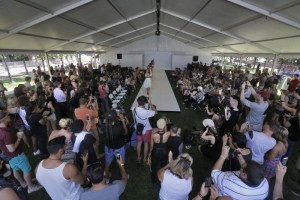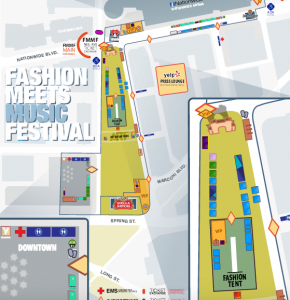PP1 – Fashion Meets Music Festival
Posted: September 8, 2015 Filed under: Connor Wescoat Leave a comment »Getting Started: I chose to document my time at Columbus’ 2nd annual Fashion Meets Music Festival (FMMF) that took place this past weekend. My organization “Heart Of It All” was featured at the festival as well as many different talented designers, brands, musicians and artists. While I have attended a few festivals in my life, this one stands out in that its lay out was a little “unconventional”. Is that good or bad? Lets find out!
Note: While I have outlined a top-down diagram in my post, I will elaborate further on the installations and lay out of the event. I chose to observe both the “Fashion Stage” where my booth was present and one of the main music stages called the “Stella Stage”. Beginning with the Fashion Stage; this stage was constructed just like a fashion runway with 2 separate smaller stages on both sides. One functioned as a regular artist stage for musicians whose performance would accompany the fashion act and the other was a raised soundboard area which functioned as the technical hub for the runway. Seating was offered on the left and right sides of the runway. While seating was available, I observed that the majority of the audience chose to stand for the event.
Map: Overall map of the event
Note: The second stage that I observed was the “Stella Stage” which functioned as the main-stage of the festival. It was not only the largest of the 4 stages but it also was situated at the back of the field which housed the most people. I observed that while the other stages would only gradually get more and more packed when an artist was about the perform, this stage remained pretty crowded. In my opinion this was because the field offered a large social area to hang out in while also offering relief from the other aspects of the festival. I also observed that people started migrating to this stage 30 minutes to an hour before a performance. In contrast to the fashion stage which would progressively fill about 10 minutes before the designer went on.
Devise: For the fashion stage, I devised an idea to implement a visual aid to the back drop of the runway to reduce standing congestion. One idea of mine would come in the form of a downloadable app that would showoff the presented garment on the viewers smartphone. The other idea was to project either a picture or a video of the presented garment on the backdrop of the runway. I believe that these methods would dampen the amount of crowding around the stage. For the Stella Stage I took a page out of the band Metallica’s stage show in the form of a centralized main stage.

With this viewpoint, people cluster around the stage rather than being in front of it. This mode, while more expensive and harder to implement, would provide more people with better views and less centralized congestion.
Conclusion: While I believe these methods would dampen the overall congestion of these high traffic areas, the context in which these bottlenecks occur is a massive festival setting at the end of the day. People being packed in like sardines is an expected outcome and even the goal of many of these popular music festivals. In my opinion, I would like to see improvement on the fashion end of the spectrum rather than the contemporary “main stage” layout that is so prevalent at today’s major music festivals. By making the fashion stage more accessible and experiential for the consumer, more people will demand events like FMMF and the programmatic quality of these events will continue to grow.
Top-Down Diagram: PP1 FMMF



